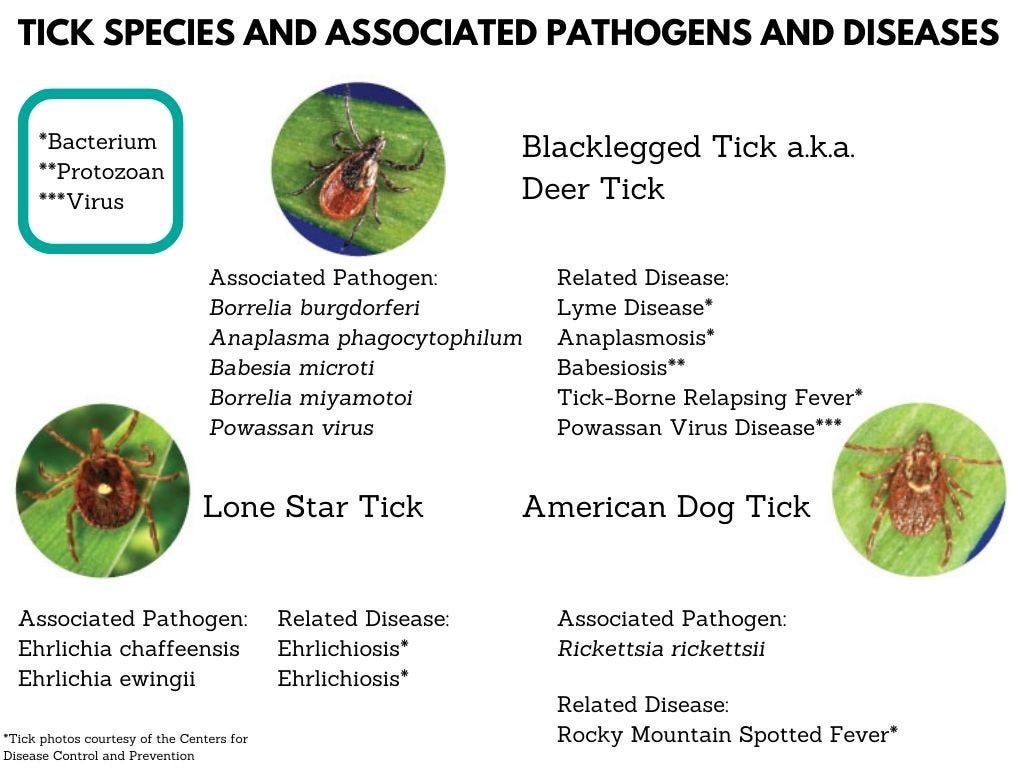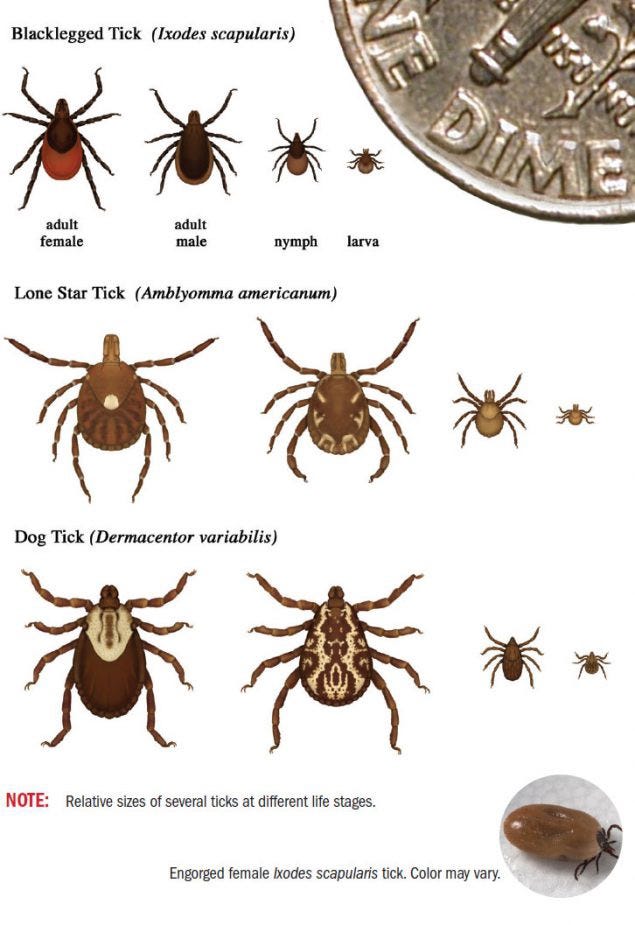By Megan Naftali
It’s hard to tell whether tick populations are increasing, but one thing is for sure: Tick-borne illness remains a big issue on Long Island, even if declining case counts may appear to suggest otherwise, experts say.
Lyme disease is the most prevalent tick-borne illness on Long Island and also underestimated, according to Dr. Scott Campbell, entomologist and laboratory chief of the Arthropod-Borne Disease Laboratory at the Suffolk County Department of Health Services.


“There appears to be decreasing trends, but Lyme disease cases are notoriously underreported,” Campbell said. “The big drop in 2020 cases is most likely due to complex effects that Covid-19 had on individual behavior and public health and healthcare systems and resources.”
There are three tick species with a higher potential risk to cause human disease, including the American dog tick, lone star tick and black-legged tick, also known as the deer tick, according to Campbell.




“There are some [ticks] that will feed on animals, and they pick up the pathogen in that blood meal. For example, the black-legged tick picks up the bacterium that causes Lyme disease from the white-footed mouse,” Campbell said. “If it bites a human, it will transmit that bacterium to the human in that subsequent blood meal.”
Lone star ticks depend on deer, and as deer populations move west, the ticks seem to follow, according to Campbell.
“As the deer population in western Suffolk County continues to grow, the frequency of negative human-deer interactions will likely increase without population management,” said Bill Fonda, regional public participation specialist at the New York State Department of Environmental Conservation. “Overabundant deer populations can damage natural communities, increase the number of deer-vehicle collisions and cause an increased risk of contracting tick-borne diseases.”
In 2016, the Suffolk County Department of Health Services started the tick surveillance program, in collaboration with the State Department of Health. The study provided insight into the types of tick-borne diseases that the three species carry by collecting ticks from Suffolk’s 10 towns and testing them for pathogens, according to the Suffolk County government website.
“Somebody walk[s] with a stick, and it’s almost like holding a broom handle down in the brush. That’s called flagging. That’s how we do [tick surveillance], because we have a thick underbrush,” Campbell said. “There’s also a very similar process called dragging, [where] they actually hold on to a rope that’s tied to a bar on both ends, and that bar drags the cloth through the vegetation.”
These processes work for tick surveillance because ticks have a certain way in which they try to latch onto a host called questing.
“You’ll see a tick basically on the end of a blade of grass with the front legs out waiting for a host to walk by and they have [their] little hooks on the end of their front legs, and once that cloth or an animal goes by, they grasp it with those hooks and they climb aboard,” Campbell said.
Many hikers on Long Island have had experiences with ticks, and some have gotten sick with tick-borne illnesses. Nicole Rotondi, a doctor of acupuncture and Chinese medicine at Acupuncture Wellness Services in Smithtown, was infected with Lyme disease and Rocky Mountain spotted fever.
“I used to hike on Long Island. I would say it was more than 10 years ago,” Rotondi said. “I never found a tick on me, and once I had Lyme, I never hiked again.”
Rotondi was misdiagnosed for two years and had severe symptoms such as body numbness and weakness, fatigue, brain fog, back pain and digestive disorders.
“I went to a neurologist because I was having numbness and tingling, and just felt really off, and every test they did on me [came back] normal,” Rotondi said. “I had asked them if they ran a Lyme panel. He [said], ‘Yes, you came back normal,’ so I continued to have these symptoms.”
After reading about chronic Lyme disease, Rotondi saw a Manhattan specialist, who ran extensive blood work and discovered that she had Lyme disease. Rotondi has done acupuncture for 23 years, and her diagnosis prompted her to learn how to treat Lyme disease with alternative medicine.
“Acupuncture is the insertion of fine needles in different areas of the body and what they do is stimulate your body in certain ways to produce healing,” Rotondi said.
She studied with anyone who knew anything about alternative medicine and analyzed the Shang Han Lun, a traditional Chinese medicine treatise that dates back close to two millennia, after her diagnosis.
“There are certain places on the body [where needles go to promote healing] for the immune system itself. [This treatment] would be used for any infection,” Rotondi said. “What makes it specific for Lyme is the particular energy work we do with it, as well as the supplementation.”




After two years of treating herself, Rotondi is asymptomatic and does not have Lyme disease or Rocky Mountain spotted fever anymore. Although she is a proponent of alternative medicine, she urges people to take the Western medicine approach first.
“If anyone ever came [to me] and had Lyme, I would always send them to their doctor first. You have to use everything at your disposal to treat Lyme,” Rotondi said. “Diagnosis and medicine first, if needed, then holistic medicine to follow up and continue the healing.”
Other hikers have been fortunate not to have contracted a tick-borne illness, but have still had negative experiences with ticks on Long Island.
“One time I was hiking in [Rocky Point State Pine Barrens Preserve], and I made it about 15 to 20 minutes in, and next thing I know, I had about 30 or 40 ticks on me crawling on my legs and stuff,” said Blake Wolfskill, of Port Jefferson Station. “I bolted out of there and did my best to get all of them off me, and I was still finding ticks for the next day around the house. That’s happened to me a number of times.”
When people enter areas of potential tick exposure, they should take several precautions, including wearing layers, tucking in clothes, using an EPA approved repellent, performing tick checks after walking the trail, and running clothes through the dryer once home to dry out and kill any ticks, according to Campbell, who recommended Permethrin repellent.
“Ticks are cold-blooded arthropods, so if it gets too hot and too dry, it may negatively impact them because they need moisture, as you can tell from putting them in the dryer,” Campbell said.
One thing to note is ticks can be found in residential areas, along with public parks throughout the year.
“Ticks will be coming out the end of March, early May and throughout the summer,” Campbell said. “The other aspect is the black-legged adult ticks are active through the winter, so there’s really no time where it’s [tick] free, so you can be bitten by ticks throughout the year.”
